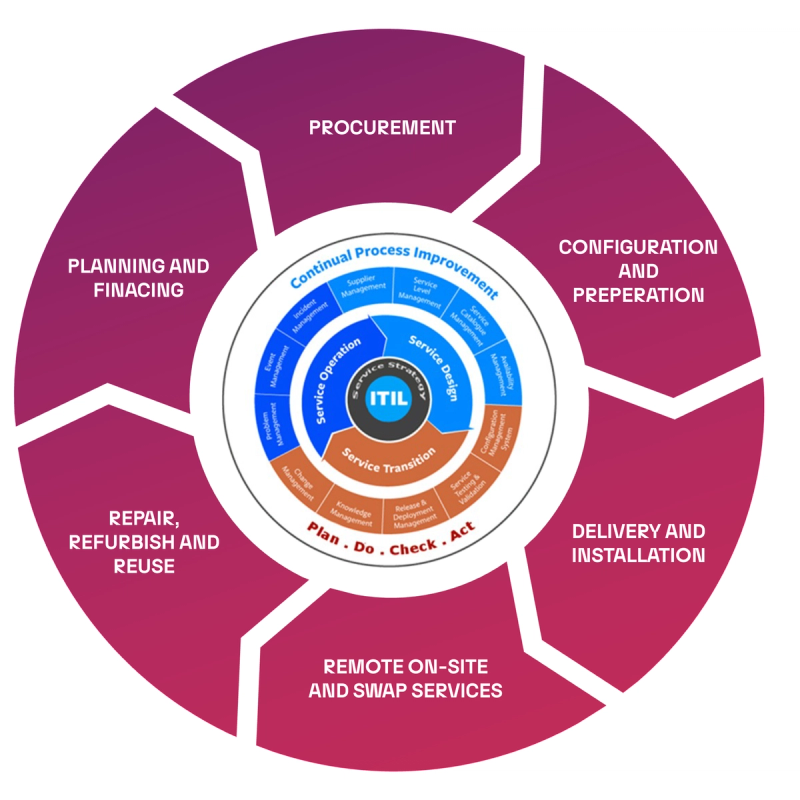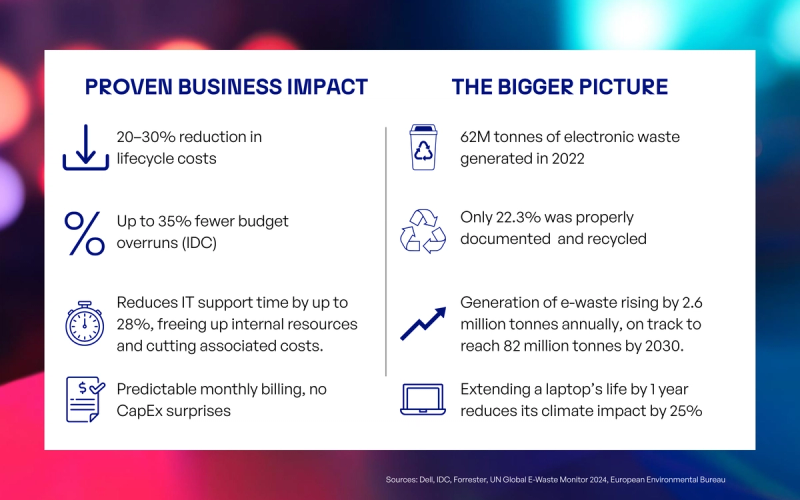XaaS: What is Anything-as-a-Service?
In today’s digital economy, the traditional approach to IT ownership is increasingly unsustainable.
Large upfront investments, complex procurement processes, and unpredictable maintenance demands place a heavy burden on businesses already under pressure to do more with less. The Anything-as-a-Service (XaaS) model offers a more practical alternative.
Not familiar with the term? While Anything-as-a-Service may sound like technical jargon, the idea behind it is simple. Instead of owning infrastructure outright and managing support in-house, you subscribe for the services you need, when you need them. Think of it as IT on demand: one tailored solution, one platform, one contract, one subscription, one support channel, one less thing to worry about.
What does XaaS actually mean?
Originally rooted in cloud computing models like Software-as-a-Service (SaaS) and Infrastructure-as-a-Service (IaaS), the concept has evolved to cover a much broader scope. Today, it extends into the physical workplace, covering everything from hardware installations and managed IT infrastructure to AI-powered retail systems.
Whether it’s Retail-as-a-Service, Device-as-a-Service (DaaS), Platform-as-a-Service (PaaS), or Office-as-a-Service the model brings together any services you might need under one single, unified subscription. We call our XaaS platform Onitio One.
This model shifts IT spending from capital expenditure (CapEx) to operational expenditure (OpEx), relieving you and your team of the ongoing burden of procurement, maintenance, and lifecycle management. The benefits are both tangible and, in most cases, immediate.
What are the benefits?
1. Lower total cost of ownership (TCO)
Most organizations underestimate the true cost of owning and operating IT infrastructure. While the purchase price of a device might seem like the main expense, it typically accounts for only 20% of the total lifecycle cost.
The remaining 80% accrues over time through maintenance, support, downtime, disposal, and administrative overhead.

Gartner estimates that businesses spend three to five times the original purchase price managing a device throughout its lifecycle. Our own analysis paints a similar picture: when factoring in support, recovery, fixes, and internal admin, lifecycle costs can exceed the purchase price by a factor of four.
The Anything-as-a-Service approach removes much of this hidden cost. By replacing large capital expenditures (CapEx) with predictable monthly operating costs (OpEx), you gain more control over your budget. It also reduces the strain on internal IT teams, minimizes unplanned downtime, and eliminates the unpleasant surprises that come with ageing hardware or fragmented infrastructure.
2. End-to-end lifecycle management
Managing IT assets internally is often resource-intensive, inconsistent, and rarely as efficient as it should be. From procurement and configuration to support and secure disposal, the process demands time, budget, and attention that many teams cannot afford.
The Anything-as-a-Service model addresses this by offering fully managed, end-to-end lifecycle support, all under one predictable subscription model.
- Devices arrive preconfigured and ready to use, which shortens onboarding time.
- Maintenance is proactive rather than reactive, reducing downtime significantly.
- Refurbishment, reuse, and recycling are integrated into the service.
When equipment reaches end-of-life, it’s refurbished, reused, or responsibly recycled, all in line with ISO 14001 environmental standards.

This approach does more than lighten the load on internal IT teams. It improves operational consistency, shortens onboarding times, and makes budgeting easier.
And the financial impact is measurable. According to our partner Dell Technologies’ report, organizations using Device as a Service (DaaS) see a 20–30% reduction in lifecycle costs. Forrester reports that adopting a DaaS model can reduce IT support time by up to 28%, freeing up internal resources and cutting associated costs. IDC found that predictable billing helps reduce hardware budget overruns by up to 35%.
But lifecycle management isn’t only a question of efficiency. It’s increasingly tied to environmental responsibility. According to The European Environmental Bureau (EEB), just extending a laptop’s life by 1 year reduces its climate impact by 25%.
In 2022, the world generated 62 million tonnes of electronic waste. Only 22.3% was formally documented and recycled, leaving US$ 62 billion worth of recoverable natural resources unaccounted for and increasing pollution risks to communities worldwide. According to the Global E-waste Monitor 2024 report, the generation of e-waste is rising by 2.6 million tonnes annually, on track to reach 82 million tonnes by 2030, a further 33% increase from the 2022 figure.

In 2021, 92% of executives cited emissions reduction as a top priority. With rising ESG expectations and tighter regulations, IT strategies must address environmental performance as well as operational goals.
The Anything-as-a-Service model, or Onitio One as we refer to it, embeds sustainability into every phase of the IT lifecycle.
- Devices are chosen for durability and energy efficiency
- Systems are maintained to extend useful life
- Equipment is recovered, reused, or recycled, not discarded
This circular approach reduces electronic waste, decreases reliance on raw materials, and lowers your carbon footprint. In essence, we move from a “buy-use-discard” mindset to one built around reuse, recovery, and responsibility.
3. Security & compliance built-in
In the current threat landscape, security is no longer a box to tick, but a baseline expectation. The financial risks of poor security are well documented. According to IBM, the average cost of a data breach in 2023 was $4.45 million. Organizations with fully deployed security automation, such as antivirus and patching, saved an average of $1.76 million per breach.
The Anything-as-a-Service model integrates core security and compliance functions directly into the IT environment, ensuring you stay protected without having to manage it all yourself. Core services include:
- Antivirus protection (via Drift Antivirus Solution)
- Automated patch management
- Active Directory operations
- Continuous remote monitoring and response
Together, these tools reduce vulnerabilities, limit exposure, and ensure systems remain secure and compliant, especially in sectors with heightened regulatory demands such as retail, healthcare, and the public sector.
By embedding these functions into the service model itself, you reduce reliance on fragmented tools and stretched internal resources. This makes it easier to meet evolving regulatory standards like GDPR, ISO 27001, and industry-specific frameworks, without compromising operational efficiency.
4. Business agility & scalability
IT should support business growth, not slow it down. A service-based subscription model like XaaS is very flexible, and designed to match your pace, whether you’re opening new locations, enabling hybrid teams, or onboarding staff at scale.
Instead of navigating lengthy procurement cycles or investing in fixed infrastructure, you can scale your IT footprint up or down as needed. Devices can be added or removed per user or site. Support levels can be adjusted to match shifting priorities, and integrations with APIs and enterprise platforms can be made without disruption.
This flexibility isn’t theoretical. For organizations with seasonal peaks, or fast growth cycles, Anything-as-a-Service offers something traditional ownership models rarely do: the ability to move fast, without overextending resources.
Take Rema 1000, for example. By adopting Retail-as-a-Service, the grocery chain scaled from 25 to 85 locations in just eight weeks. Preconfigured hardware, coordinated logistics, and a managed rollout allowed for fast, frictionless growth, without the usual delays or overhead.
Summary
Adopting an Anything-as-a-Service model, what we call Onitio One, is not simply about outsourcing IT. It’s about moving away from traditional ownership models that are expensive, rigid, and resource-heavy, and toward a more agile, subscription-based way of managing technology.
This shift gives you greater control over costs, faster access to better tools, and the ability to scale as your organization evolves.
It replaces high upfront capital expenditure (CapEx) with predictable operating costs (OpEx), while also reducing hidden overhead tied to maintenance, downtime, and administration.
Security and compliance are also built in, with automated patching, antivirus, identity management, and continuous monitoring, all maintained without adding pressure on internal teams.
Crucially, this approach also helps you meet your sustainability targets. By embedding circular economy practices, that is, reuse, refurbishment, and responsible recycling, you can reduce your environmental footprint. And with lifecycle services included, your team can focus on higher-value work, not asset management.